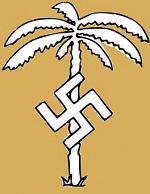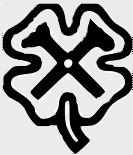Hobby Master HG4501 German Horch 108 Type 1A Command Car with 20mm FlaK Gun - 71.Infanterie Division, Deutsches Afrika Korps, Libya, 1941 (1:72 Scale)
"The peril of the hour moved the British to tremendous exertions, just as always in a moment of extreme danger things can be done which had previously been thought impossible. Mortal danger is an effective antidote for fixed ideas."
- Generalfeldmarschall Erwin Rommel
 One of the problems presented by the original policy of purchasing commercially based vehicles for military usage was the vast diversity of makes taken on to the inventory, and the associated maintenance and spares supply problem. Different makes of engine, transmission, chassis, and so on meant that the stock of spares needed was immense. Thus, once the big armament programme got under way, it was decided in 1934 to replace the range of commercially based chassis with a new range of standardised chassis types. It was intended that the three classes of field car, light, medium, and heavy, would have many parts in common, including suspension units, and that the light and heavy cars would have steerable wheels at the front and back, and would have four wheel drive. This proved to be too ambitious an ideal, even from the start, for the cost and time factor involved in developing such a sophisticated series of vehicles was immense. Only the early vehicles had rear wheel steering, and this requirement was dropped in 1940 to simplify production. Auto-Union/Horch were the main builders of both the medium and heavy passenger cars in the Einheits programme (einheitsfahrgestell: standard motor chassis).
One of the problems presented by the original policy of purchasing commercially based vehicles for military usage was the vast diversity of makes taken on to the inventory, and the associated maintenance and spares supply problem. Different makes of engine, transmission, chassis, and so on meant that the stock of spares needed was immense. Thus, once the big armament programme got under way, it was decided in 1934 to replace the range of commercially based chassis with a new range of standardised chassis types. It was intended that the three classes of field car, light, medium, and heavy, would have many parts in common, including suspension units, and that the light and heavy cars would have steerable wheels at the front and back, and would have four wheel drive. This proved to be too ambitious an ideal, even from the start, for the cost and time factor involved in developing such a sophisticated series of vehicles was immense. Only the early vehicles had rear wheel steering, and this requirement was dropped in 1940 to simplify production. Auto-Union/Horch were the main builders of both the medium and heavy passenger cars in the Einheits programme (einheitsfahrgestell: standard motor chassis).
The Auto Union/Horch Chassis I for heavy passenger cars (schwerer personenkraftwagen) was produced in 1935. As part of the overall plan it was intended to use this chassis with a rear mounted engine for armoured cars and with a front mounted engine for passenger cars. The original chassis with steerable wheels front and back was designated I a, and the later production chassis (from 1939-40) was designated I b. The chassis featured four wheel drive. There was a torque converter with a limited differential action to prevent winding up in the transmission. The front axle was driven directly from the main gearbox, which included a third differential. There were five forward gear ratios, one reverse, and an auxiliary low gear for cross country work. There was a self locking differential on the rear axle with a normal differential at the front, this arrangement ensuring that all wheels received driving power no matter what the nature of the terrain. There was a fully independent suspension, each wheel having two radius arms sprung by two coil springs between the power radius arm and a bracket on the chassis frmae. Shock absorbers were incorporated into the suspension to prevent damage to the steering arms. The four wheel steering facilty proved to be unsatisfactory in the long term. The rear wheel steering was optional, controlled by a dog clutch operated by a lever from the driving position. Using four wheel steering and driving fast, the vehicle was found to slew sideways; thus it was not popular and after some experience four wheel steering was forbidden altogether at speeds over 13 mph. This limitation made the whole facility of such slight value that it was droped entirely from the 1940 onward production chassis.
Field car production with this chassis started late in 1938. Externally all Auto-Union/Horch heavy cars looked alike irrespective of actual chassis model, however. By 1940 the chassis had been simplified considerably, and the Berlin Ford factory was also by then engaged in production. Ford built vehicles had a Ford 3.6 litre V-8 78 hp engine in place of the Horch unit. The late 1940 models lacked recesses in the body and chassis mounted support arms for spare wheels. Production ceased in 1941 in favor of a new scheme under the Schell-Programm which sought to rationalize car production completely. In this scheme the heavy car shared the chassis of the 1.5 ton light truck. Auto-Union/Horch heavy cars remained in service throughout World War II, however, and were among the most common of German vehicles on every front. The Auto-Union/Horch on the heavy passenger car chassis was used in several roles, and though the layout of the open body followed the old Kubelsitzer idea, all but the very earliest had the added refinement of metal side doors rather than canvas side screens.
Pictured here is a 1:72 scale replica of a German Horch 108 Type 1A command car with towed 20mm FlaK gun which served with the Deutsches Afrika Korps during their drive across Libya in 1941.
Sold Out!
Dimensions:
Length: 2-1/2-inches
Width: 1-1/4-inches
Release Date: October 2010
 Historical Account: "With the Fox" - The Afrika Korps was formed on February 19th, 1941, after the German Armed Forces High Command (OKW) had decided to send an expeditionary force to Libya to support the Italian army, which had been routed by an Allied counteroffensive, Operation Compass. The German expeditionary force, commanded by Erwin Rommel, at first consisted only of the 5. Panzer-Regiment and various other small units. These elements were organized into the 5. Leicht-Division when they arrived in Africa in February.
Historical Account: "With the Fox" - The Afrika Korps was formed on February 19th, 1941, after the German Armed Forces High Command (OKW) had decided to send an expeditionary force to Libya to support the Italian army, which had been routed by an Allied counteroffensive, Operation Compass. The German expeditionary force, commanded by Erwin Rommel, at first consisted only of the 5. Panzer-Regiment and various other small units. These elements were organized into the 5. Leicht-Division when they arrived in Africa in February.
In the spring, the 5.Leicht-Division was joined by the 15.Panzer Division, though it did not arrive until Rommel had already re-taken most of Cyrenaica and gone back over to the defensive. At this time the
Afrika Korps consisted of the two divisions plus various smaller supporting units, and was officially subordinated to the Italian chain of command in Africa (though Rommel had conducted his offensive without any authorization).
On October 1st, 1941, the 5.Leicht-Division was redesignated as the 21.Panzer Division, although it was still attached to the
Afrika Korps. During the summer of 1941, the OKW invested more command structure in Africa by creating a new headquarters called Panzer Gruppe Afrika. On August 15th, Panzer Gruppe Afrika was formally activated with Rommel in charge, and command of the Afrika Korps was turned over to Ludwig Cruewell. The Panzer Gruppe controlled the Afrika Korps plus some additional German units that were sent to Africa, as well as two corps of Italian units. (A German "group" was approximately the equivalent of an army in other militaries, and in fact Panzer Gruppe Afrika was redesignated as Panzer Armee Afrika on January 30th, 1942.)





 DAK Horch 108 Car with 20mm anti-aircraft gun
DAK Horch 108 Car with 20mm anti-aircraft gun 


